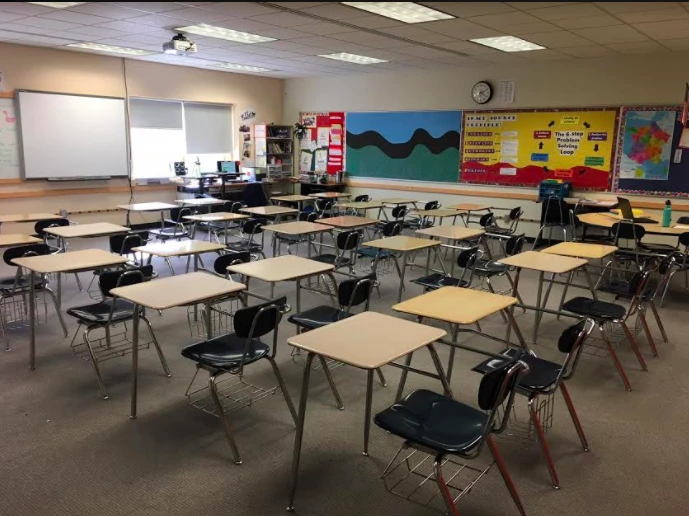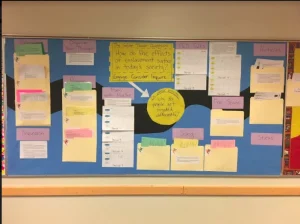Which activity should I choose? What do I do when I’m done? Can you help me?
Do these student questions sound familiar?
Questions like these tend to come up when you start implementing choice boards in your classroom. The good news is that you’ve already laid the groundwork. You thoughtfully designed the assignments. You created a schedule and task cards to to set your students up for success. (If you are just starting your choice board journey, check out our first two posts: To Shift or Not To Shift and Pulling Back the Curtain). We have been working on the choice board model together for the past two years, and if you are interested in learning more about our relationship and our work, please see our previous posts.
Now here comes the hard part: managing the process. Not only have you shifted your instructional approach, you have also shifted your classroom culture. Instead of telling students, you are asking them. Instead of teacher-directed lessons, your students are making choices. In the beginning it may feel like your classroom has turned into a battlefield. Don’t wave the white flag just yet! We believe that student-centered classrooms are worth fighting for, and in this post we will share strategies and tips for managing the day-to-day trials and tribulations. We can reassure you that once you have established routines and procedures, you can begin to retreat, and let your students march on.
Julie: If I walked into your classroom and your students were working on a choice board, what would I see them doing? What would I hear them saying?
Darcy: You would see a myriad of things. Overall, you would see students sitting alone, in pairs, or in a small group; students would be sitting at the back table with me, some students would have Chromebooks, accessing content online; some would have paper-based assignments at their desks, and there would be students out of their seats in search of task cards.
On some days you might see a smaller class. Because the students are independently working, and I have paraprofessionals assigned to some of my class periods, sometimes a small group will go to the library to work. The small groups can be a mixed-ability level of students or a purposefully selected group of students. When we hand-pick the students, the aid takes a certain assignment or has a particular goal for the group to work on under her guidance. Sometimes the small group is simply used to change the behavior dynamics in the class–both for the students in and out of the small group!
You would also see a couple of students NOT on task, but the advantage is that I am not competing with them for the attention of the class by direct instructing. This means I am no longer feeling frustrated in front of the group. And, when I do need the whole group’s attention, they are more engaged because I no longer ask them to be quiet for long periods of instruction.
You would hear students asking each other about where to find the assignments, asking each other for direction clarification, and discussing content with each other to complete their work. The volume can fluctuate between quiet and conversation level. Sometimes I set a timer for a specific amount of quiet just to get students in work-mode.
Julie: What classroom setup do you think lends itself to the choice board model?
Darcy: It’s just so funny that this has all evolved slowly over the years, but I can cut to the chase and help everyone get there faster with my story! To start, I actually got rid of my “teacher desk” about three years ago. It had become too easy (and tempting) to slink over and detach from my students. I wanted to re-engage and be with my students, building relationships and helping them. Since then, I just have a table with my desktop computer at the front of the room in order to run my Smartboard. I never “work” there during class — if I did, my back would be to middle schoolers!
Another piece of the evolution is that when this whole choice board journey started, I had been reflecting on how my daughter’s elementary school classes did rotating stations and choice time–I couldn’t help but fantasize about incorporating small groups into my language arts classes. That sparked my search for the iconic kidney-shaped table that graces so many elementary classrooms. Within a few weeks, one arrived at my school. It was actually quite comical because the custodian had to find different table legs to make it tall enough for middle school-sized students. To this day it is a little wiggly from being at the tallest leg setting, but we are comfortable!
I love my kidney-shaped table, though. If I sit to work, that is where I am–available for students to come and sit with me, work with me, and maybe just have a change of scenery. I use it primarily for small group instruction, and the students use it for small group work–it is a hub of activity.
Most of the time for choice board work, the desks are arranged in three rows of pairs. This facilitates pair-share work in whole-group activities and keeps the students in a fairly regimented seating chart. Also, since I don’t run the choice board every day of the week, the rows help manage student behavior the rest of the weekdays. Students move desks as they need to during independent work time. Some students are not allowed to work together based on their observed levels of productivity. On the occasion a student completely needs to have their own space, and I have a desk outside of my classroom to accommodate them.
When running a small group assignment as part of the choice board, students will come to me at the kidney-shaped table. I do move the table around the room when I need to. One time I started my small group with a paper-based presentation, but immediately found that students could not easily see it or follow along. For the next group, I re-positioned the table in front of the Smartboard and put a Notebook file together–lesson saved!

A snapshot of the classroom and the kidney shaped table.
Julie: Here is a question I’m asked frequently. While the students are working on the choice board, what does the teacher do?
Darcy: The absolute coolest thing about choice boards is that there’s only ever a small handful of students working on the same assignment at any-given time, and rarely are they at the same part of the assignment, so it is so much easier to be available for one-on-one time. I taught a whole-group lesson one day earlier this year and within a few minutes, realized the stress I caused myself–hands were flying up all over the place and soon my aid and I were running around the room trying to get to everyone.
In a choice board setting, this just doesn’t happen. After training students to consciously read directions (by the way it’s 4th quarter and we’re still working on this, BUT according to my students’ most recent check-in survey, they feel like they are still improving in this area), they become better problem-solvers and are likely to ask a peer for direction clarification.
So in between the handful of questions at a low-stress pace, I will help students find assignments, organize their work, check in on their calendar and progress, help students with their work, talk to students and push their thinking, redirect those two or three students who keep getting distracted, and I can do some light work at my kidney shaped table for a few minutes at a time; for example, I can send short parent emails, upload assignments onto our LMS, research content to use in class, etc. Remember, because I sit at the “hub” of my classroom, students can come sit right next to me or across from me and I am available whenever they need.
Julie: One of our biggest priorities in working on choice boards was creating activities that would meet each student where s/he is at. How do you manage differentiating your instruction within the choice board model?
Darcy: This is exciting to talk about. You introduced me to the mild, medium, and spicy strategy, where the level of spice is the level of difficulty. To help my students and I stay organized, I color-code my handouts: green is mild, yellow is medium, and pink is spicy; the task cards are also color coded to match the levels. It makes it easier to grade and I know which level of assignment students are working on. I also want to point out that not every assignment on my choice board offers the mild, medium, and spicy differentiation. Sometimes I want everyone to do the same assignment, and that is part of my choice board design. If you’re thinking that it is a lot of work to prepare three levels of assignments, you are right! That’s why you can start small–just level one assignment and start from there.
When I launch the choice board with the spice levels, I make a bulletin board spread with our essential question posted on it. I have assignment headings from the choice board and then have a folder for each level underneath.

Example of my choice board bulletin board, complete with sign-up sheets for the small group and computer time, ready for students.
Students self-select their level of assignment. The medium assignment is geared towards the on grade level student and this is what I expect to see most students choose. The mild is for below-proficient, and the spicy is for the high-achieving students. I try to streamline assignments which means that all three levels are essentially the same format, but the text varies in complexity and the last question or two in the assignment will be more or less difficult.
Choice Board Assignment: Poem
Purpose (This is articulated on the task card):
- Make connections between the author’s life and their work
- Practice using quotes in written responses
- Evaluate author’s purpose
Mild: “I Know Why the Caged Bird Sings” by Paul Laurence Dunbar
- Read the author’s biography
- Read the poem.
- Identify 3 luminous lines (important lines) in the poem by underlining them.
- For each of the 3 lines, use the sentence frame and write out your thoughts:
When the poem says, “________________________,” it made me think about …
After completing the thought, write one tell me more exploring your thinking.
Now consider the author’s purpose with the following sentence frame:
The author’s purpose for writing this poem is…
Explore your thinking with at least 2 more tell me mores.
Medium: “Busted Boy” by Simon Ortiz
- Read the author’s biography.
- Read the poem.
- Identify 3 luminous lines (important lines) in the poem by underlining them.
- For each of the 3 lines, use the sentence frame and write out your thoughts:
When the poem says, “________________________,” it made me think about …
After completing the thought, write one tell me more exploring your thinking.
Now consider the author’s purpose with the following sentence frame:
The author’s purpose for writing this poem is…
Explore your thinking with at least 2 more tell me mores.
Spicy: “I Hear America Singing” by Walt Whitman and “I, Too, Sing America” by Langston Hughes
- Read the authors’ biographies.
- Read the poems.
- To the side of each poem, make a list 3 big ideas you see and indicate the text that supports those ideas.
- Compare and/or contrast each of the ideas with the sentence frame:
In “[put title of poem here],” the idea of _____________ compares/contrasts with “[put other poem title here]” through/by…
After completing the thought, write one tell me more exploring your thinking.
Now consider each author’s purpose with the following sentence frames:
Walt Whitman’s purpose for writing his poem is…
Langston Hughes’s purpose for writing his poem is to…
Explore your thinking about these two authors’ poems with at least 2 more tell me mores.
The assignment frame is essentially the same for each level. The text difficulty separates the mild and medium. The spicy assignment is the most difficult because students go deeper by comparing and contrasting two related poems instead of just analyzing one.
Part of differentiation is offering a variety of activities on the choice board. I have done this by offering assignments based on poetry, informational texts, music, and videos. When I have several types of media, I try to make assignments similar, like I do between levels. Along with the poem assignment shown above, there were assignments looking at a music video and a primary source. The assignment for each of those parallelled the poem: identifying important lines, using quotes in the written response with a sentence frame, and the author’s purpose. I feel like if students are familiar with a routine, they can focus more on the content
Julie: What systems have you developed to track what your students are working on?
Darcy: Because my students complete most of their work in composition notebooks and I only collect them twice a quarter, I have started using Google Spreadsheet to track my students’ progress. I make a master file with the students’ names going down the sheet and the assignments across the top–it has the mild, medium, and spicy colors. Once a week during work time I have students log their progress. I am able to see who has picked which level and if they are “in-progress” with it (they enter “IP”), or have the assignment “completed” (they enter a “C”). Not only does this help me know who is doing what, but it also helps facilitate other opportunities, like peer sharing. We will go further into this in the next post.
Julie: What have been your biggest management challenges?
Darcy: The first management challenge is catching the students that “look” like they are working, but nothing is actually being done. The ones who are obviously side-chatting can be separated, and most students make decent progress in the time they are given. The ones who appear to be working are harder to manage. When I figure out who they are, I will check in with them more frequently, or ask them to come back to my table and work next to me, or send them with the small group.
I typically do not see finished choice board assignments until the deadline. I mentioned earlier that almost all of my students’ work is completed in their composition notebooks, and I only collect them twice a quarter. There is an established routine for our notebook checks that involves a checklist, a work day, and plenty of forewarning. First of all, students are given a checklist a week in advance that lists the assignments that should be completed. That same day, I send an email home to parents with the checklist attached and the due date for the notebook. Parents are reminded that all task cards and assignments are available on our LMS and are encouraged to physically look at their student’s notebook to double-check assignments. This process can catch some of the students who appear to be working, but are not. Students are also given one more work day in class to make sure everything is ready to be graded.
Another challenge with management is when I use the mild, medium, and spicy levels. Some students don’t level themselves correctly and end up trying an assignment that is too difficult. I will gently encourage them to try the assignment I think they should do, or work with them to get through the more complex assignment. Sometimes I talk up the appropriate assignment by mentioning how much less time they will spend on it, and that might convince them. In the end when I grade, if a student who attempted a difficult assignment shows that they are stretching their learning and are on the right track, their grade reflects it. Most students will push themselves if you let them.
Some students use every minute of their class time–which is wonderful, but then they finish the choice board with time to spare. I have used what I call a “Free Space” list, where students can choose what to do from a list. Julie also gave me the idea to have “Genius Time.” This is an ongoing project that students can work on whenever they have extra time in class–I launched my Genius Time as a passion project. I wanted the students to use reading and writing to track and document what they are most interested in.
The last challenge is managing small groups during independent work time. The first time I ran a small group station I scheduled two 20-minute groups back to back in the same class period–did I get a guffaw? I learned very quickly that 20 minutes was way too long for a small group AND I could not be unavailable to my class for 40 minutes. Not only did students have questions, but behaviors started to erupt. From that point on, I scheduled no more than one 15-minute group per class period. I also do not offer the small group on every work day because I get tired of teaching the lesson!
A valuable classroom tool to employ during choice boards that Julie shared with me is where you have a non-verbal signal system using color-coded cards. If students are feeling unsure about what they are doing, they put a yellow card on their desk. If students are totally stuck, they use a red card. This eliminates the need for students to sit with their hands up.
Darcy and Julie’s Tips For Managing Choice Boards
Problem: Too much variety in assignments: students are stuck and can’t get started because they don’t know what to choose
Solution: Ask students what their favorite assignment is and encourage them to start there.Make sure their calendar is filled in so they have a plan. It looks less overwhelming when it can be worked on day by day.
Problem: The volume of the class is too loud
Solution: Set a timer for “quiet time”. If possible, turn the volume down so students won’t hear it go off, and they will keep working quietly! Demonstrate the level that is acceptable. Have students start at a whisper and raise their volume in small increments so they can hear what the maximum volume is.
Problem: Students are surrounding you and asking questions
Solution: Employ a non-verbal signal for communicating needs. Envelopes stapled to a bulletin board can house red and yellow cards. Students can place a card on their desk to let you know what they need.
Yellow = I may need some help,
Red = I need help now.
Problem: Students finish their work early
Solution: Have extension activities ready to go. This can be a list of activities, or you can have an established “Genius Time” in practice.
Problem: Assignments are hard to keep track of
Solution: Use composition notebooks, folders, or packets of handouts to help keep things straight.
As a teacher who is trying a new instructional approach you can sometimes feel like you are on the front lines of a battle. Don’t retreat or put up a white flag if things don’t go well the first time. In our next post, we will share tips and strategies for choice board assessment and providing your students with feedback and opportunities to share their work. We would also love to hear from you! What questions do you have about choice boards that we haven’t answered yet?








